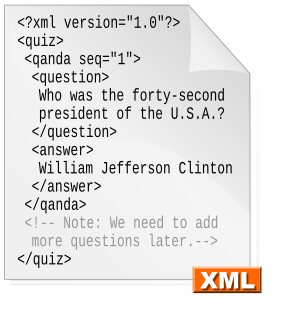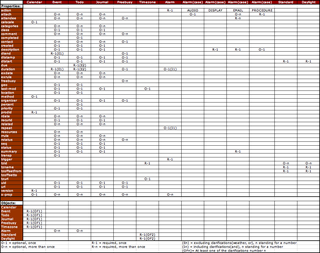This page is based on this
Wikipedia article Text is available under the
CC BY-SA 4.0 license; additional terms may apply.
Images, videos and audio are available under their respective licenses.
In computing, the Java API for XML Processing, or JAXP, one of the Java XML Application programming interfaces (API)s, provides the capability of validating and parsing XML documents. It has three basic parsing interfaces:
Schematron is a rule-based validation language for making assertions about the presence or absence of patterns in XML trees. It is a structural schema language expressed in XML using a small number of elements and XPath.
XSL-FO is a markup language for XML document formatting that is most often used to generate PDF files. XSL-FO is part of XSL, a set of W3C technologies designed for the transformation and formatting of XML data. The other parts of XSL are XSLT and XPath. Version 1.1 of XSL-FO was published in 2006.
An XML editor is a markup language editor with added functionality to facilitate the editing of XML. This can be done using a plain text editor, with all the code visible, but XML editors have added facilities like tag completion and menus and buttons for tasks that are common in XML editing, based on data supplied with document type definition (DTD) or the XML tree.
Apache AxKit was an XML Apache publishing framework run by the Apache foundation written in Perl. It provided on-the-fly conversion from XML to any format, such as HTML, WAP or text using either W3C standard techniques, or flexible custom code.
In computing, the two primary stylesheet languages are Cascading Style Sheets (CSS) and the Extensible Stylesheet Language (XSL). While they are both called stylesheet languages, they have very different purposes and ways of going about their tasks.

The Oxygen XML Editor is a multi-platform XML editor, XSLT/XQuery debugger and profiler with Unicode support. It is a Java application, so it can run in Windows, Mac OS X, and Linux. It also has a version that can run as an Eclipse plugin.
An XML framework is a Software framework that implements features to aid the programmer in creating applications with all data produced in XML. The programmer defines and produces pure data in XML format and the framework transforms the document to any format desired. One code, one XML and several transformations like XHTML, SVG, WML, Excel or Word format, or other document type may result.
XQuery is a query and functional programming language that queries and transforms collections of structured and unstructured data, usually in the form of XML, text and with vendor-specific extensions for other data formats. The language is developed by the XML Query working group of the W3C. The work is closely coordinated with the development of XSLT by the XSL Working Group; the two groups share responsibility for XPath, which is a subset of XQuery.

yEd is a general-purpose diagramming program with a multi-document interface.

An XML transformation language is a programming language designed specifically to transform an input XML document into an output document which satisfies some specific goal.
Machine-readable data, or computer-readable data, is data in a format that can be easily processed by a computer.
Stylus Studio is an integrated development environment (IDE) for the Extensible Markup Language (XML). It consists of a variety of tools and visual designers to edit and transform XML documents and legacy data such as electronic data interchange (EDI), comma-separated values (CSV) and relational data.
Tritium is a simple scripting language for efficiently transforming structured data like HTML, XML, and JSON. It is similar in purpose to XSLT but has a syntax influenced by jQuery, Sass, and CSS versus XSLT’s XML based syntax.




